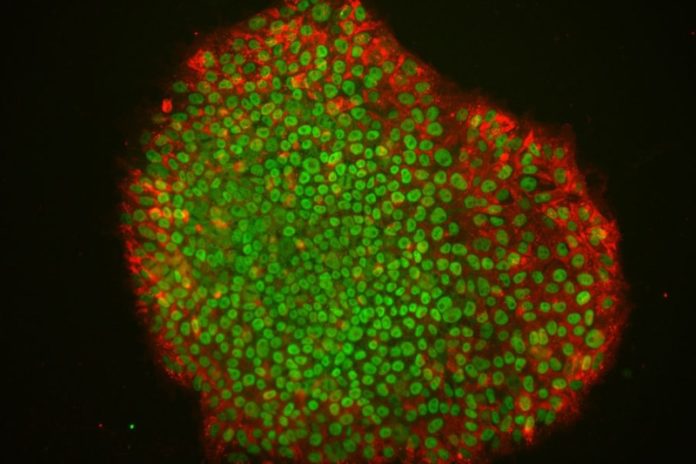
A team led by New York Stem Cell Foundation (NYSCF) Research Institute scientists conducted a study comparing induced pluripotent stem (iPS) cells and embryonic stem cells created using somatic cell nuclear transfer (SCNT). The scientists found that the cells derived from these two methods resulted in cells with highly similar gene expression and DNA methylation patterns. Both methods also resulted in stem cells with similar amounts of DNA mutations, showing that the process of turning an adult cell into a stem cell introduces mutations independent of the specific method used. This suggests that both methods of producing stem cells need to be further investigated before determining their suitability for the development of new therapies for chronic diseases.
The NYSCF Research Institute is one of the only laboratories in the world that currently pursues all forms of stem cell research including SCNT and iPS cell techniques for creating stem cells. The lack of laboratories attempting SCNT research was one of the reasons that the NYSCF Research Institute was established in 2006.
“We do not yet know which technique will allow scientists to create the best cells for new cellular therapies,” said Susan L. Solomon, NYSCF CEO and co-founder. “It is critical to pursue both SCNT and iPS cell techniques in order to accelerate research and bring new treatments to patients.”
While both techniques result in pluripotent stem cells, or cells that can become any type of cell in the body, the two processes are different. SCNT consists of replacing the nucleus of a human egg cell or oocyte with the nucleus of an adult cell, resulting in human embryonic stem cells with the genetic material of the adult cell. In contrast, scientists create iPS cells by expressing a few key genes in adult cells, like a skin or blood cell, causing the cells to revert to an embryonic-like state. These differences in methods could, in principle, result in cells with different properties. Advances made earlier this year by NYSCF Research Institute scientists that showed that human embryonic stem cells could be derived using SCNT revived that debate.
“Our work shows that we now have two methods for the generation of a patient’s personal stem cells, both with great potential for the development of treatments of chronic diseases. Our work will also be welcome news for the many scientists performing basic research on iPS cells. It shows that they are likely working with cells that are very similar to human embryonic stem cells, at least with regard to gene expression and DNA methylation. How the finding of mutations might affect clinical use of stem cells generated from adult cells is the subject of an ongoing debate,” said Dr. Dieter Egli, NYSCF Senior Research Fellow, NYSCF — Robertson Investigator, Assistant Professor in Pediatrics & Molecular Genetics at Columbia University, and senior author on the paper.
The study, published today in Cell Stem Cell, compared cell lines derived from the same sources using the two differing techniques, specifically contrasting the frequency of genetic coding mutations seen and measuring how closely the stem cells matched the embryonic state through the analysis of DNA methylation and of gene expression patterns. The scientists showed that both methods resulted in cell types that were similar with regard to gene expression and DNA methylation patterns. This suggested that both methods were effective in turning a differentiated cell into a stem cell.
The scientists also showed that cells derived using both SCNT and iPS techniques showed similar numbers of genetic coding mutations, implying that neither technique is superior in that regard. A similar number of changes in DNA methylation at imprinted genes (genes that are methylated differentially at the maternal versus the paternal allele) were also found. It is important to note that both types of techniques led to cells that had more of these aberrations than embryonic stem cells derived from an unfertilized human oocyte, or than embryonic stem cells derived from leftover IVF embryos. These findings suggest that a small number of defects are inherent to the generation of stem cells from adult differentiated cells and occur regardless of the method used.
Story Source:
The above story is based on materials provided by New York Stem Cell Foundation. Note: Materials may be edited for content and length.
Journal Reference:
- Bjarki Johannesson, Ido Sagi, Athurva Gore, Daniel Paull, Mitsutoshi Yamada, Tamar Golan-Lev, Zhe Li, Charles LeDuc, Yufeng Shen, Samantha Stern, Nanfang Xu, Hong Ma, Eunju Kang, Shoukhrat Mitalipov, Mark V. Sauer, Kun Zhang, Nissim Benvenisty, Dieter Egli. Comparable Frequencies of Coding Mutations and Loss of Imprinting in Human Pluripotent Cells Derived by Nuclear Transfer and Defined Factors. Cell Stem Cell, 2014; 15 (5): 634 DOI: 10.1016/j.stem.2014.10.002
